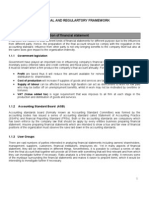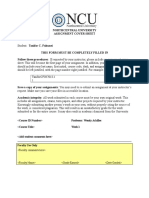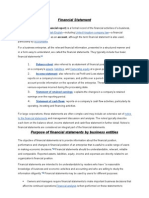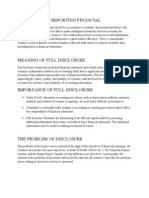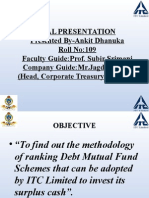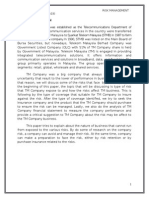CH 01 SM 9e
CH 01 SM 9e
Uploaded by
Sophia HaJeong KimCopyright:
Available Formats
CH 01 SM 9e
CH 01 SM 9e
Uploaded by
Sophia HaJeong KimOriginal Title
Copyright
Available Formats
Share this document
Did you find this document useful?
Is this content inappropriate?
Copyright:
Available Formats
CH 01 SM 9e
CH 01 SM 9e
Uploaded by
Sophia HaJeong KimCopyright:
Available Formats
CHAPTER 1 GOVERNMENTAL AND NONPROFIT ACCOUNTING: ENVIRONMENT AND CHARACTERISTICS
ANSWERS TO QUESTIONS
Question 1-1 a. The similarities of accounting for profit-seeking and G&NP organizations include: 1. 2. 3. Double-entry system of accounts. Most accounting mechanics, e.g., basic transaction documents, journals, ledgers, charts of accounts. Where a G&NP organization has a business-type activity, e.g., a municipal electric utility, the accounting largely parallels that for a similar private business (e.g., electric utility).
b.
Among the unique aspects of G&NP organization accounting are: 1. 2. Fund accountingdesigned to separate resources according to the purposes for which they may be used and to account for their uses and balances. Budgetary control techniquesto help assure appropriations are not overexpended and all resources due the G&NP organization are received by it.
Question 1-2 a. A fund of a government organization is an independent fiscal and accounting entity. Each fund has a separate self-balancing set of accounts in which are recorded the resources segregated for specific purposes, the related liabilities and residual equity (fund balance or net assets), and the changes therein. Financial statements typically must be presented to report the financial position and operating activities of a fund of a government. As the term is generally used in commercial accounting, a "fund" merely indicates that a portion of an organization's assets is set aside and/or restricted to certain uses, e.g., a petty cash fund or a bond sinking fund. Such "funds" are not separate accounting entities, but are accounted for by establishing appropriately titled asset and liability accounts within the organization's general ledger. No, the creation of a fund does not constitute authority to spend or obligate its resources. In most not-for-profit organizations, particularly governments, authority to spend or obligate fund resources is conferred only upon an appropriation(s) being made by the legislative body or governing board.
2009 Pearson Education, Inc. publishing as Prentice Hall
b.
c.
Question 1-3 1. Governmental (expendable) funds are used to account for the financial assets; related liabilities; changes in net financial assets from revenues, expenditures, and other financing sources (uses); and the balances that may be expended in a G&NP organization's "governmental" or other" nonproprietary" activities. Proprietary (nonexpendable) funds are used to account for the revenues, expenses, assets, liabilities, and equity of a G&NP organization's "business-type" activities.
2.
Question 1-4 "Expenditures" may be defined as the amount of net financial resources expended during an accounting period for current operations, capital outlay, and long-term debt principal retirement and interest. (Expenditures are measured in governmental/expendable fund accounting.) "Expenses," on the other hand, are the costs of assets or services consumed (expired) during an accounting period. (Expenses are measured in proprietary fund accounting.) When equipment is purchased for instance, expenditures are incurred; but expenses are incurred during its period of use. Question 1-5 a. Organizational objectives. The determination of net income, earnings per share, change in owner(s) equity, and the like are very important in accounting for profit-seeking organizations. Such measurements relate directly to the objectives of the owners and are seen to indicate management success or failure during a given period of time. On the other hand, a G&NP organization exists to provide certain goods or services to a community or society as a whole. The objective of such organizations is to provide as many goods or as much service as available resources permit. Emphasis in this environment is therefore upon acquiring and using appropriable financial resourcescash flow, working capital, and budgetary positionrather than the determination of net income or earnings per share. b. Sources of financial resources. Profit-seeking organizations generally rely on equity investors, debt issuances, and profits from the sale of goods and services to its customers to generate financial resources. In contrast, G&NP organizations do not have investors, and generally do not have a profit motive. G&NP organizations generally rely on the receipt of taxes and donations as their primary sources of financial resources although they also rely, to some degree, on proceeds from debt issuances. Grants and subsidies from governments are primary sources of financial resources for many G&NP organizations as well. Bureau of the Census statistics indicated that resources received from senior levels of government actually exceed taxes for many local governments.
2009 Pearson Education, Inc. publishing as Prentice Hall
c. Evaluating Performance and Operating Results. Profit-seeking organizations rely on profits from the sale of its goods or services to continue to operate. The operations of a profit-seeking organization generally are evaluated based on the amounts of profits (or its net income) over a period of time. G&NP organizations must be measured differently Question 1-5 (continued) because G&NP organizations generally do not have a profit motive. Evaluating the performance of governments is extremely difficult because there is no open market supply and demand test of the value of the services that they provide. Also, the relationship between resource providers and the recipients of services is remote and indirect for G&NP organizations. Therefore, other controls must be substituted for the profit test/regulator where G&NP organizations are involved. Thus, G&NP organizations, particularly governments, are subjected to a variety of legal and administrative controls over such factors as (1) organization structure, (2) personnel policies and procedures, (3) sources of resources, (4) uses of resources, (5) accounting, (6) reporting, and (7) auditing. The most obvious result of such alternative controls is the extensive use of fund accounting and reporting and budgetary accounting and reporting by G&NP organizations Question 1-6 1. The Governmental Accounting Standards Board (GASB) was established in 1984 as the recognized body to set authoritative standards for state and local government accounting and financial reporting. The GASB recognized the effective National Council on Governmental Accounting (NCGA) pronouncements and excerpts from certain AICPA publications as "authoritative" in 1984, and subsequently has issued numerous Statements and Interpretations. The Financial Accounting Standards Board (FASB) assumed responsibility for all nonbusiness organization accounting and financial reporting standards except those for state and local governments in 1979. The FASB establishes accounting and financial reporting standards for all nonprofit organizations except for government nonprofit organizations. (Although not discussed in chapter 1, it may be interesting to note that the FASB issued Statement of Financial Accounting Standards (SFAS) No. 116, "Accounting for Contributions Made and Contributions Received" and SFAS 117, "Financial Statements of Not-for-Profit Organizations" in June 1993. The FASB has since issued two additional standards specifically addressing not-for-profit organization accounting issues. These standards established the general guidelines for financial reporting for all nongovernment not-for-profit organizationsincluding nongovernment not-for-profit hospitals, colleges and universities, voluntary health and welfare organizations, and other not-for-profit organizations. Government not-for-profit entities of these types, e.g., state universities, are prohibited from applying these SFASs.)
2.
2009 Pearson Education, Inc. publishing as Prentice Hall
Question 1-7 User charges of profit-seeking organizations may be presumed to be set at a level that is expected to maximize short-run or long-run profitability. A potential user who cannot pay the user charges is denied the goods or services. In G&NP organizations, on the other hand, user charges may be set at modest levels that assure that most or all people needing the goods or services can obtain them. The user charges may be made more as a matter of assuring that the users truly need the goods or services and/or to assure that the self-respect of those who will not accept "charity" is protected. In other G&NP activities user charges may be set at a "break even" level or at levels that provide some "profit" to be used to expand or improve its services. Question 1-8 The term "generally accepted accounting principles" has been defined broadly as: 1. 2. encompassing the conventions, rules, and procedures necessary to define accepted accounting practice at a particular time, and including not only broad guidelines of general application, but also detailed practices and procedures. (APB Statement No. 4, par. 138). Thus, GAAP is an "umbrella" term that encompasses many "subsets" in the private sector (e.g., motion pictures, oil and gas, banking) as well as in the public sector (e.g., state and local governments, hospitals, colleges and universities, and nonprofit organizations).
Question 1-9 a. The AICPA GAAP "hierarchy guidelines provide accountants and auditors a ranking device by which to evaluate the relative authoritativeness of various standards pronouncements and other accounting and reporting publications in order to determine what constitutes "generally accepted accounting principles" for a given type of organization and the transactions and events affecting its financial condition and/or operating results. The government GAAP hierarchy establishes GASB Statements and Interpretations as the most authoritative literature guiding financial reporting for state and local government entities. Therefore, in preparing GAAP financial statements, a government should apply the guidance in a GASB Statement even when it conflicts with guidance provided in an AICPA audit and accounting guide (or in any other literature).
b.
2009 Pearson Education, Inc. publishing as Prentice Hall
Question 1-10 The GASB and FASB jointly established a definition of state and local government entities that appears in various AICPA audit and accounting guides (Illustration 1-1, page 8). This definition should be referred to in determining whether a specific not-for-profit organization should follow GASB guidance or FASB guidance. If the organization meets the definition of state and local government entities, it is under the GASBs jurisdiction and should follow GASB guidance. If the organization does not meet the state and local government entities definition, it is under the FASBs jurisdiction and should follow FASB guidance. SOLUTIONS TO EXERCISES Exercise 1-1 1. 2. 3. 4. 5. 6. 7. d d c b a d e (Note: Adoption by the GASB makes a FASB pronouncement equivalent to, or part of, a GASB pronouncement.) 8. c 9. e 10. c Exercise 1-2 (a) Expenses $100,000 24,000 5,500 (b) Expenditures $100,000 24,000 5,500 10,000 30,000
1. 2. 3.
4.
5.
Salaries and other personnel costs ............................................ Rent and utilities......................................................................... Debt service: a) Interest on note .............................................................. b) Note principal payment ...................................................... Capital outlay/Depreciation: a) Capital outlay ...................................................................... b) Depreciation of equipment i) $150,000/15 = $10,000 ii) ($30,000-$6,000)/6 = 4,000 Other ........................................................................................... Total .................................................................................. 5
14,000 4,500 $148,000
4,500 $174,000
2009 Pearson Education, Inc. publishing as Prentice Hall
SOLUTIONS TO PROBLEMS Problem 1-1 1. General Fund Hatcher Township Worksheet to Derive Accrual Basis Statement of Revenues and Expenditures FYE December 31, 20X9 ($) Budgetary (Cash) Basis Revenues: Taxes ............................... Licenses .......................... Intergovernmental .......... Other ...............................
Accruals 1/1/X9 12/31/X9
GAAP Basis
$595,000$ 206,000 110,000 45,000 956,000
$ 6,000 (9,000) (5,000) $(14,000)
$601,000 1,000 $ 7,000
206,000 102,000 40,000 949,000
Expenditures: Salaries ............................ Utilities ........................... Supplies ........................... Equipment ....................... Other ...............................
704,000 85,000 64,000 58,000 31,000 942,000
$(17,000) (2,000) $(19,000)
$11,000 7,000 12,000 $30,000
698,000 85,000 71,000 68,000 31,000 $953,000
Excess of Revenues Over (under) Expenditures . Reconciliation (Not Required):
$ 14,000
$ (4,000)
Excess of Revenues Over (Under) ExpendituresBudgetary (Cash) Basis . Decrease in Revenue accruals at 12/31/X9 ..................................................... (7,000) Increase in Expenditure accruals at 12/31/X9 ................................................. (11,000)
2009 Pearson Education, Inc. publishing as Prentice Hall
$14,000
Excess of Revenues Over (Under) ExpendituresGAAP Basis ................... (4,000)
2009 Pearson Education, Inc. publishing as Prentice Hall
Problem 1-1 (continued) 2. Yes, readers would get differing impressions of the 20X9 "operating results" of the Hatcher Township General Fund from statements of revenues and expenditures prepared on the budgetary (cash) and GAAP bases. For example: a. b. Revenues exceeded expenditures by $14,000 on the budgetary (cash) basis; but expenditures exceeded revenues by $4,000 on the GAAP basis. Revenue and expenditure analyses and evaluations would differ:
Budget Revenues: Taxes ........................................................ Intergovernmental ................................... Other ........................................................ Expenditures: Salaries .................................................... Supplies ................................................... Equipment ...............................................
Actual (Budgetary Basis)
Actual (GAAP Basis)
$600,000 100,000 50,000
$595,000 110,000 45,000
$601,000 102,000 40,000
700,000 70,000 60,000
704,000 64,000 58,000
698,000 71,000 68,000
Problem 1-2 The possible sources of guidance found for each issue are listed below in decreasing order of authoritativeness. Documents at the same level of authority are given the same rank since one does not always take precedence over the other. (Levels A-E are from the GAAP Hierarchy in Illustration 1-4, page 12, of the textbook.) Issue 1 1. 2. 2. 4. 4.
(a)GASB Interpretation (b)GASB Technical Bulletin (b)AICPA SLG Audit and Accounting Guide ("cleared" by the GASB) (e)FASB Statement (which has not been "adopted" in a GASB Statement) (e)Leading governmental accounting textbook
2009 Pearson Education, Inc. publishing as Prentice Hall
Problem 1-2 (continued) Issue 2 1. 2. 2. 2. (d)GASB staff Implementation Guide (e)Leading governmental accounting textbook (e)Article in a leading auditing journal (e)Speech by a leading governmental accounting professor
Issue 3 1. (a)GASB Statement 2. (b)AICPA SLG Audit and Accounting Guide (cleared by the GASB) 3. (e)Journal article that summarizes current practice on the issue in the United States 4. (e)Notes from a telephone conversation on the issue with the GASB director of research 4. (e)FASB Interpretation (unless adopted by the GASB) Issue 4 1. 1. 3. 3.
(b)GASB staff Technical Bulletin (b)AICPA Statement of Position (cleared by the GASB) (e)Article by the managing partner of an international public accounting firm (e)FASB Technical Bulletin
Issue 5 1. (b)AICPA SLG Audit and Accounting Guide (cleared by the GASB) 2. (d)GASB Codification section on a GASB staff Implementation Guide (has the same level of authority as the Implementation Guide) 3. (e)Four articles from The Journal of Accountancy 3. (e)Leading governmental accounting textbook
Problem 1-3 Work on P1-3 should be evaluated by reviewing the brief (1-3 pages) critiques required and any attachments. The addresses of these sites are: 1. 2. 3. 4. 5. 6. 7. 8. GASB (http://www.GASB.org) FASB (http://www.FASB.org) AICPA(http://www.AICPA.org) GFOA (http://www.GFOA.org) AGA (http://www.AGACGFM.org) NASACT (http://www.NASACT.org) NACUBO (http://www.NACUBO.org) ASBOINTL (http://ASBOINTL.org)
2009 Pearson Education, Inc. publishing as Prentice Hall
Problem 1-4 The GASB White Paper can be found at the GASB website (www.gasb.org). The executive summary to the White Paper is a brief summary that identifies the key differences between governments and for-profit business enterprises.
2009 Pearson Education, Inc. publishing as Prentice Hall
10
You might also like
- Cheating SheetDocument13 pagesCheating SheetAlfian Ardhiyana PutraNo ratings yet
- Ch.1 Questions & AnswersDocument4 pagesCh.1 Questions & Answersgdghf33% (3)
- Financial Statement AnalysisDocument26 pagesFinancial Statement AnalysisJade Gomez100% (2)
- Anthony Robbins - Money - Masrter The GameDocument40 pagesAnthony Robbins - Money - Masrter The GameikerpagazaNo ratings yet
- Inventory and Risk Management-AbstractDocument2 pagesInventory and Risk Management-AbstractSaritha ReddyNo ratings yet
- Immediate download Solution Manual for Governmental and Nonprofit Accounting Theory and Practice 9th Edition by Freeman all chaptersDocument44 pagesImmediate download Solution Manual for Governmental and Nonprofit Accounting Theory and Practice 9th Edition by Freeman all chaptersbubismarcef0100% (3)
- Question 1-1Document3 pagesQuestion 1-1Mohamed BarakatNo ratings yet
- Solution Manual For Governmental and Nonprofit Accounting Theory and Practice 9th Edition by Freeman All Chapter Instant DownloadDocument46 pagesSolution Manual For Governmental and Nonprofit Accounting Theory and Practice 9th Edition by Freeman All Chapter Instant Downloadqatiparmero100% (1)
- All Chapter Download Solution Manual For Governmental and Nonprofit Accounting Theory and Practice 9th Edition by FreemanDocument44 pagesAll Chapter Download Solution Manual For Governmental and Nonprofit Accounting Theory and Practice 9th Edition by Freemankeydanhenby100% (2)
- Accounting For Public CHAPTER ONE-WPS OfficeDocument14 pagesAccounting For Public CHAPTER ONE-WPS Officehaymanot gizachewNo ratings yet
- Ch-1 Acct For P&CSDocument7 pagesCh-1 Acct For P&CSDawit NegashNo ratings yet
- Accounting For Governmental & Nonprofit Entities 15/e Chapter 1 SolutionsDocument8 pagesAccounting For Governmental & Nonprofit Entities 15/e Chapter 1 SolutionsJeannie Bopes Carter100% (6)
- NFP Lecture NotesDocument20 pagesNFP Lecture NotesAdugnaNo ratings yet
- Finance For Non-Finance Executives: The Concept of Responsibility CentresDocument31 pagesFinance For Non-Finance Executives: The Concept of Responsibility Centressuresh.srinivasnNo ratings yet
- AfPS&CS Ch-01Document10 pagesAfPS&CS Ch-01Amelwork AlchoNo ratings yet
- Chapter OneDocument14 pagesChapter OneChera HabebawNo ratings yet
- 01 GNFP Chapter OneDocument20 pages01 GNFP Chapter Onesabit hussenNo ratings yet
- PublicDocument66 pagesPublicObsa QabaadhuNo ratings yet
- Public Sector AccountingDocument9 pagesPublic Sector AccountingBekanaNo ratings yet
- AccountingDocument29 pagesAccountingMukeshChhawariNo ratings yet
- Term Debt Is Not Recorded As A LiabilityDocument3 pagesTerm Debt Is Not Recorded As A Liabilitychristian dag100% (1)
- Ch.2 PGDocument12 pagesCh.2 PGkasimNo ratings yet
- Government and Not-for-Profit Accounting Concepts and Practices Granof 6th Edition Solutions Manual PDF Download Full Book With All ChaptersDocument51 pagesGovernment and Not-for-Profit Accounting Concepts and Practices Granof 6th Edition Solutions Manual PDF Download Full Book With All Chapterswanagoljerko100% (4)
- Chapter One Overview of Governmental and Not For Profit Organizations 1.0. Learning ObjectivesDocument24 pagesChapter One Overview of Governmental and Not For Profit Organizations 1.0. Learning ObjectivesshimelisNo ratings yet
- Government and NFP Assignment SolutionDocument5 pagesGovernment and NFP Assignment SolutionHabte DebeleNo ratings yet
- ACCTNG 5568 Homework 1Document5 pagesACCTNG 5568 Homework 1Sanjida DorothiNo ratings yet
- Section 1 FRDocument6 pagesSection 1 FRHellena LenggengNo ratings yet
- GaapDocument7 pagesGaapjoyceNo ratings yet
- Questions and Exercises GOVE'T CH-1Document8 pagesQuestions and Exercises GOVE'T CH-1GETAHUN ASSEFA ALEMUNo ratings yet
- Chapter 1Document10 pagesChapter 1abdirazakhNo ratings yet
- Fge Group Assignment No.1&2Document6 pagesFge Group Assignment No.1&2Emebet TesemaNo ratings yet
- PronouncementDocument23 pagesPronouncementPhilipa Meilinda PutriNo ratings yet
- Summary 2Document5 pagesSummary 2Karin NafilaNo ratings yet
- Solution Manual For Introduction To Government and Not For Profit Accounting 6th Edition by IvesDocument4 pagesSolution Manual For Introduction To Government and Not For Profit Accounting 6th Edition by Ivesa736945285100% (1)
- FSA3e HW Answers Modules 1-4Document39 pagesFSA3e HW Answers Modules 1-4bobdole0% (1)
- Chapter Two Principles of Accounting and Financial Reporting of Government EntitiesDocument13 pagesChapter Two Principles of Accounting and Financial Reporting of Government EntitiesHenok FikaduNo ratings yet
- HND, Unit 10, Level 5Document26 pagesHND, Unit 10, Level 5Abrar Khan MarwatNo ratings yet
- TaniforCFIN7018 8 1Document13 pagesTaniforCFIN7018 8 1Che Tanifor BanksNo ratings yet
- Financial Accounting/Corporate AccountingDocument7 pagesFinancial Accounting/Corporate AccountingY TEJASWINI0% (1)
- Financial Statement: British English United Kingdom Company LawDocument4 pagesFinancial Statement: British English United Kingdom Company Lawkumar kunduNo ratings yet
- State and Local Government Accounting and Financial Reporting Model: The FoundationDocument20 pagesState and Local Government Accounting and Financial Reporting Model: The FoundationTatiana Rotaru100% (1)
- Objectives of Financial ReportingDocument3 pagesObjectives of Financial ReportingAnurag GargNo ratings yet
- Chapter 1Document6 pagesChapter 1Dùķe HPNo ratings yet
- Conceptual Framework - 0Document9 pagesConceptual Framework - 0alabaaleahmarieNo ratings yet
- Fra - Ese Final Notes Feb23Document32 pagesFra - Ese Final Notes Feb23mohdsahil2438No ratings yet
- Exam 1 Study Guide GovermentalDocument21 pagesExam 1 Study Guide GovermentalCarey ToccoNo ratings yet
- Download full Solution Manual for Government and Not-for-Profit Accounting: Concepts and Practices, 8th Edition, H. Granof all chaptersDocument31 pagesDownload full Solution Manual for Government and Not-for-Profit Accounting: Concepts and Practices, 8th Edition, H. Granof all chaptersglemzamyleen100% (2)
- Handout Revised For GA Spring 2018-19Document93 pagesHandout Revised For GA Spring 2018-19mauyd9494No ratings yet
- Basic Financial Statement: It's Importance: Reflection Paper OnDocument34 pagesBasic Financial Statement: It's Importance: Reflection Paper OnpolmalondaNo ratings yet
- Governmental and Nonprofit Accounting: Environment and CharacteristicsDocument12 pagesGovernmental and Nonprofit Accounting: Environment and CharacteristicsMadchestervillainNo ratings yet
- Governmental and Not-For-Profit AccountingDocument30 pagesGovernmental and Not-For-Profit Accountingmiadjafar463No ratings yet
- Choice of Accounting Policy: Effects On Analysis and Interpretation of Financial StatementsDocument5 pagesChoice of Accounting Policy: Effects On Analysis and Interpretation of Financial Statementsabcd123No ratings yet
- Legal Aspects of Business AccountingDocument5 pagesLegal Aspects of Business AccountingswaggerboxNo ratings yet
- Notes To The Financial Statements Are Additional Notes and Information Added To The End of TheDocument9 pagesNotes To The Financial Statements Are Additional Notes and Information Added To The End of TheReal AptitudeNo ratings yet
- Chapter One Overview of Financial Reporting For Government and NFP EntitiesDocument11 pagesChapter One Overview of Financial Reporting For Government and NFP Entitiescherinetbirhanu8No ratings yet
- Chapter 1 Governmental AccountingDocument12 pagesChapter 1 Governmental AccountingMoh ShiineNo ratings yet
- Chapter 8 - Accounting For Governmental and Nonprofit Entities - 16th - SMDocument19 pagesChapter 8 - Accounting For Governmental and Nonprofit Entities - 16th - SMmaylee0105No ratings yet
- Government Accountant: Federal Accounting Standards Advisory Board (FASB) - Government Accounting Standards Board (GASB)Document5 pagesGovernment Accountant: Federal Accounting Standards Advisory Board (FASB) - Government Accounting Standards Board (GASB)Glaiza GiganteNo ratings yet
- Chapter One Accounting Principles and Professional PracticeDocument22 pagesChapter One Accounting Principles and Professional PracticeHussen Abdulkadir100% (1)
- Accounting For Public Sector and Civil Society 2022 LatestDocument170 pagesAccounting For Public Sector and Civil Society 2022 LatestZerai Hagos HailemariamNo ratings yet
- C213 Study Guide - SolutionDocument23 pagesC213 Study Guide - Solutiondesouzas.ldsNo ratings yet
- Report On DisclosureDocument15 pagesReport On Disclosuredeath_heavenNo ratings yet
- "The Language of Business: How Accounting Tells Your Story" "A Comprehensive Guide to Understanding, Interpreting, and Leveraging Financial Statements for Personal and Professional Success"From Everand"The Language of Business: How Accounting Tells Your Story" "A Comprehensive Guide to Understanding, Interpreting, and Leveraging Financial Statements for Personal and Professional Success"No ratings yet
- Practice Question - Financial Statement AnalsysiDocument5 pagesPractice Question - Financial Statement AnalsysiAsadullah SherNo ratings yet
- 77554d PDFDocument83 pages77554d PDFNebojsa RedzicNo ratings yet
- Trend AnalysisDocument75 pagesTrend AnalysisAtiguptaNo ratings yet
- Financial Statement AnalysisDocument28 pagesFinancial Statement AnalysisSachin Methree75% (4)
- Formula Sheet FinanceDocument3 pagesFormula Sheet FinancecomllikNo ratings yet
- Comparable Company AnalysisDocument9 pagesComparable Company AnalysisJack JacintoNo ratings yet
- 1 s2.0 S1048984318303217 Main PDFDocument15 pages1 s2.0 S1048984318303217 Main PDFmazazNo ratings yet
- ITC Project ReportDocument50 pagesITC Project ReportKeshavNo ratings yet
- PWC Pres 080206 Bacon eDocument64 pagesPWC Pres 080206 Bacon eabhishek210585No ratings yet
- Book Building ProcessDocument3 pagesBook Building ProcessgiteshNo ratings yet
- Corporate Valuation, Value-Based Management, and Corporate GovernanceDocument12 pagesCorporate Valuation, Value-Based Management, and Corporate GovernanceCOLONEL ZIKRIANo ratings yet
- CAIIB Questions Case StudiesDocument18 pagesCAIIB Questions Case StudiesSreejith BhattathiriNo ratings yet
- Income Statement - FUSTER GARDEN SUBDIVISION 2020Document15 pagesIncome Statement - FUSTER GARDEN SUBDIVISION 2020Ma Teresa B. CerezoNo ratings yet
- Only Problems BetaDocument4 pagesOnly Problems BetaSupriya Rane0% (1)
- Axis Bank Report.Document11 pagesAxis Bank Report.Rajat NidoniNo ratings yet
- Full Asaimen Risk ManagementDocument14 pagesFull Asaimen Risk ManagementHaiqal Abu BakarNo ratings yet
- DCF Valuation Sheet For CiplaDocument114 pagesDCF Valuation Sheet For CiplaGourav BansalNo ratings yet
- Honda Altas Cars Balance Sheet 2005 2006 Share Capital and ReservesDocument17 pagesHonda Altas Cars Balance Sheet 2005 2006 Share Capital and Reservesnaina5No ratings yet
- Ch. 15 Capital StructureDocument69 pagesCh. 15 Capital StructureScorpian MouniehNo ratings yet
- 2006 s2 SolutionsDocument22 pages2006 s2 SolutionsVinit DesaiNo ratings yet
- Rakesh Jhunjhunwala Portfolio - October 2011Document1 pageRakesh Jhunjhunwala Portfolio - October 2011neo269No ratings yet
- Pledge AgreementDocument9 pagesPledge AgreementjosefNo ratings yet
- M&A project-IIMK - TESTDocument34 pagesM&A project-IIMK - TESTSohom KarmakarNo ratings yet
- Hedge Fund Basics - IRSDocument21 pagesHedge Fund Basics - IRSmejocoba82No ratings yet
- PIK FacilitiesDocument4 pagesPIK FacilitiesChaz SilvestriNo ratings yet
- Construction of The Implied Volatility SmileDocument69 pagesConstruction of The Implied Volatility Smileapi-3748391100% (1)


























